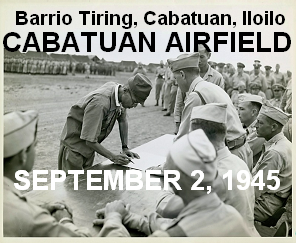
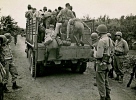
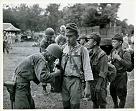
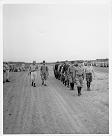
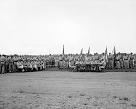
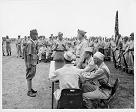
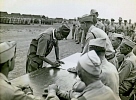
Col. Ryoichi Tozuka signs the surrender instrument
as Col. Raymond G. Stanton looks on.
Cabatuan Airfield
Barrio Tiring, Cabatuan, Iloilo
Panay Island, Philippines, September 2, 1945
|
|
- o -
|
9.2 A Raiding Unit
The radio reported that the attack on Japan was drawing near. Far away from us, large ships passed more frequently going to and coming from the harbor in Iloilo City. The US forces once again started to attack the Mizutani force. They learned their lesson and their shells and bullets hit with more precision. An observation plane also flew by to confirm the hits.
We kept passive while the US forces led the war. Not content to wait o, for the one-sided attack, however, some forces volunteered to storm the enemy at night. The unit commander ordered the Yoshioka force to do this since it had a lot of combat experience. For this purpose, 2nd Lieutenant Okuda volunteered to be the commander of the Raiding Unit.
On the night of the raid, at around 2 a.m., we heard fierce shooting towards the American position that lasted for some time before the stillness returned. In the morning, Captain Yoshioka came out smiling broadly with several US ration tins. They had also captured batteries for the wireless radio and transceiver or walkie-talkie.
Towards the end of July, American radio broadcasts reported the complete occupation of Okinawa. In preparation for the landing on Japan, B29s also dropped tons of bombs on Japan itself.
After that, the US forces continued attacks, in the same style. The Japanese tried another night attack with two raiding units but did not succeed this time.
About 500 men of the Saitô machine-gun force – the Noda unit of the 1st company Company of the Tanabe unit, the Ika Hôjin Company, and the Fukutome unit of the 1st Company who joined the others in the mountains – kept moving in the mountains west of Janiuay and Lambunao. They built a position at the foot of Mt. Singit, 11 kilometers west of Lambunao. Only the guerrillas attacked this Japanese position, and there were no major encounters here like those at Bocari.
|
|